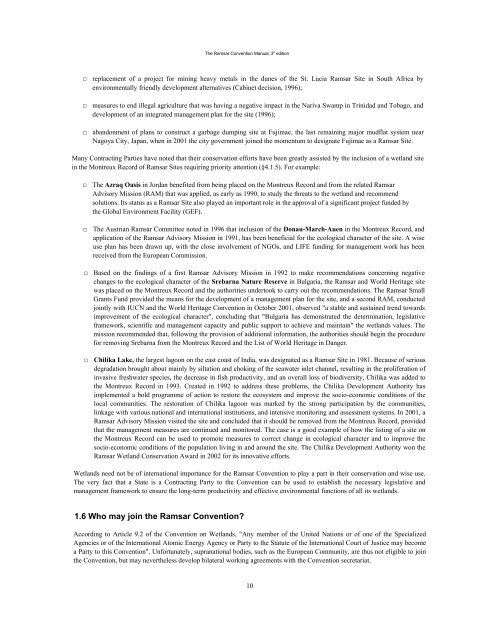The Ramsar Convention Manual.pdf
The Ramsar Convention Manual.pdf
The Ramsar Convention Manual.pdf
Create successful ePaper yourself
Turn your PDF publications into a flip-book with our unique Google optimized e-Paper software.
<strong>The</strong> <strong>Ramsar</strong> <strong>Convention</strong> <strong>Manual</strong>, 3" edition<br />
□ replacement of a project for mining heavy metals in the dunes of the St. Lucia <strong>Ramsar</strong> Site in South Africa by<br />
environmentally friendly development alternatives (Cabinet decision, 1996);<br />
□ measures to end illegal agriculture that was having a negative impact in the Nariva Swamp in Trinidad and Tobago, and<br />
development of an integrated management plan for the site (1996);<br />
□ abandonment of plans to construct a garbage dumping site at Fujimae, the last remaining major mudflat system near<br />
Nagoya City, Japan, when in 2001 the city government joined the momentum to designate Fujimae as a <strong>Ramsar</strong> Site.<br />
Many Contracting Parties have noted that their conservation efforts have been greatly assisted by the inclusion of a wetland site<br />
in the Montreux Record of <strong>Ramsar</strong> Sites requiring priority attention (§4.1.5). For example:<br />
□ <strong>The</strong> Azraq Oasis in Jordan benefited from being placed on the Montreux Record and from the related <strong>Ramsar</strong><br />
Advisory Mission (RAM) that was applied, as early as 1990, to study the threats to the wetland and recommend<br />
solutions. Its status as a <strong>Ramsar</strong> Site also played an important role in the approval of a significant project funded by<br />
the Global Environment Facility (GEF).<br />
□ <strong>The</strong> Austrian <strong>Ramsar</strong> Committee noted in 1996 that inclusion of the Donau-March-Auen in the Montreux Record, and<br />
application of the <strong>Ramsar</strong> Advisory Mission in 1991, has been beneficial for the ecological character of the site. A wise<br />
use plan has been drawn up, with the close involvement of NGOs, and LIFE funding for management work has been<br />
received from the European Commission.<br />
□ Based on the findings of a first <strong>Ramsar</strong> Advisory Mission in 1992 to make recommendations concerning negative<br />
changes to the ecological character of the Srebarna Nature Reserve in Bulgaria, the <strong>Ramsar</strong> and World Heritage site<br />
was placed on the Montreux Record and the authorities undertook to carry out the recommendations. <strong>The</strong> <strong>Ramsar</strong> Small<br />
Grants Fund provided the means for the development of a management plan for the site, and a second RAM, conducted<br />
jointly with IUCN and the World Heritage <strong>Convention</strong> in October 2001, observed "a stable and sustained trend towards<br />
improvement of the ecological character", concluding that "Bulgaria has demonstrated the determination, legislative<br />
framework, scientific and management capacity and public support to achieve and maintain" the wetlands values. <strong>The</strong><br />
mission recommended that, following the provision of additional information, the authorities should begin the procedure<br />
for removing Srebarna from the Montreux Record and the List of World Heritage in Danger.<br />
□ Chilika Lake, the largest lagoon on the east coast of India, was designated as a <strong>Ramsar</strong> Site in 1981. Because of serious<br />
degradation brought about mainly by siltation and choking of the seawater inlet channel, resulting in the proliferation of<br />
invasive freshwater species, the decrease in fish productivity, and an overall loss of biodiversity, Chilika was added to<br />
the Montreux Record in 1993. Created in 1992 to address these problems, the Chilika Development Authority has<br />
implemented a bold programme of action to restore the ecosystem and improve the socio-economic conditions of the<br />
local communities. <strong>The</strong> restoration of Chilika lagoon was marked by the strong participation by the communities,<br />
linkage with various national and international institutions, and intensive monitoring and assessment systems. In 2001, a<br />
<strong>Ramsar</strong> Advisory Mission visited the site and concluded that it should be removed from the Montreux Record, provided<br />
that the management measures are continued and monitored. <strong>The</strong> case is a good example of how the listing of a site on<br />
the Montreux Record can be used to promote measures to correct change in ecological character and to improve the<br />
socio-economic conditions of the population living in and around the site. <strong>The</strong> Chilika Development Authority won the<br />
<strong>Ramsar</strong> Wetland Conservation Award in 2002 for its innovative efforts.<br />
Wetlands need not be of international importance for the <strong>Ramsar</strong> <strong>Convention</strong> to play a part in their conservation and wise use.<br />
<strong>The</strong> very fact that a State is a Contracting Party to the <strong>Convention</strong> can be used to establish the necessary legislative and<br />
management framework to ensure the long-term productivity and effective environmental functions of all its wetlands.<br />
1.6 Who may join the <strong>Ramsar</strong> <strong>Convention</strong><br />
According to Article 9.2 of the <strong>Convention</strong> on Wetlands, "Any member of the United Nations or of one of the Specialized<br />
Agencies or of the International Atomic Energy Agency or Party to the Statute of the International Court of Justice may become<br />
a Party to this <strong>Convention</strong>". Unfortunately, supranational bodies, such as the European Community, are thus not eligible to join<br />
the <strong>Convention</strong>, but may nevertheless develop bilateral working agreements with the <strong>Convention</strong> secretariat.<br />
10












